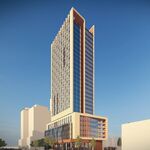Voltz
Senior Member
Which is exactly why I'm proposing (temporary) terminuses at Jane and Don Mills, that way the section between the 2 proposed LRT lines (hopefully the Don Mills LRT gets morphed into the northeast extension of the DRL instead, but that's beside the point) is subway. Higher capacity, reliable, expandable (like I said earlier, start with 4 car trainsets like on Sheppard. If ridership demand increases, add on more cars). Have the rest of the line made up of BRT, which is much cheaper to build than LRT, and that can be easily replaced if the line is extended in either direction.
The TTC sees running an express bus (technically not even BRT) between Sheppard-Yonge and Downsview as being an acceptable solution, so why not a BRT between Eglinton-Don Mills and Kennedy? I would imagine that passenger demand on that portion of the Eglinton line would be roughly the same as the Sheppard West express bus.
The main concern I would have with building the inner section as a subway (to be extended later as some have suggested), is that I don't see any chance of the outer sections requiring a subway for a very long time, as there are several other east west routes running through that part of the city (the BD subway, and the Lakeshore and future Midtown GO lines).
And what is with this "LRT fans" BS? I could just as easily surmise that you are a subway lover, since you are proposing a line that is unnecessary and provides worse service than what is currently proposed.




